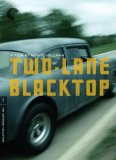| Reviews & Columns |
|
Reviews DVD TV on DVD Blu-ray 4K UHD International DVDs In Theaters Reviews by Studio Video Games Features Collector Series DVDs Easter Egg Database Interviews DVD Talk Radio Feature Articles Columns Anime Talk DVD Savant Horror DVDs The M.O.D. Squad Art House HD Talk Silent DVD
|
DVD Talk Forum |
|
|
| Resources |
|
DVD Price Search Customer Service #'s RCE Info Links |
|
Columns
|
|
|
Two-Lane Blacktop - Criterion Collection
THE MOVIE:
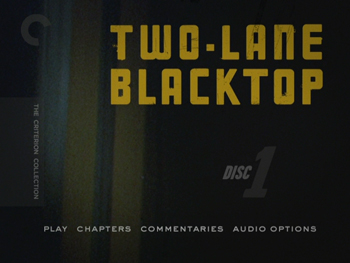
B-movies and genre pictures are quite often more than they seem. Sure, most of them are exactly what they seem, and I've seen plenty that others have claimed have carried some heavy message only to discover that someone misread nonsense for wisdom. When it's working, though, when the cast and crew understand what kind of Trojan Horse they're loading into the projector, it can be truly magical.
Monte Hellman's 1971 road race movie Two-Lane Blacktop, just released on a double-disc DVD by the Criterion Collection, can be watched as a film about a trio of guys with no roots looking for kicks on the open highway, and on that alone, it's an enjoyable flick. That's the beauty of the stealth genre picture, it has very real pleasures right on the surface. It's up to the individual to find any more in it, and in the case of Two-Lane Blacktop, whatever it is you find is also up to interpretation.
Hellman and screenwriter Rudy Wurlitzer (Walker) take a Spartan approach to their cast list. The characters have identifiers in place of names. Folk singer James Taylor is "The Driver," while Dennis Wilson, drummer for the Beach Boys and one-time misguided associate of Charles Manson, is "The Mechanic." They roam the country in a tricked-out 1955 Chevy, drag racing for money and thrills. They say very little, and when they do speak, it's usually about the car and the road. On their way through the Southwest, they keep getting buzzed by a 1970 Pontiac GTO (the cars get credits, too). It's driven by Peckinpah-mainstay Warren Oates, named only for the car himself. "GTO" is the opposite of the Chevy duo. He likes to chat up a storm, bending the ears of the hitchhikers he regularly picks up off the side of the road. What he says isn't always the God's honest truth, and his stories will change from one airing to the next. To hear him tell it, it's the Chevy that keeps landing on his tail, not the other way around.
Eventually, these two cars end up on a race to Washington D.C. The loser surrenders his pink slip and the car it represents. Along the way, they change positions in the race about as often as they pass the only other passenger, a nameless "Girl" (Laurie Bird), between their vehicles. Their attention seems to rarely be on the contest, anyway. The Chevy can't resist shorter races (sometimes compelled by financial concerns), whereas GTO's ever-changing ride-alongs trace a nature trail along America's weird underbelly.
Which, arguably, is what Two-Lane Blacktop is really about: the state of the American frontier. With Manifest Destiny all played out, modern day cowboys no longer have any territory left to explore. Instead, they shoot back and forth across the map looking for something to do. No roots, no responsibilities, just keep moving. The Chevy duo has only their thrills to look forward to. The very fact that they have nothing else--no family, no past, at least as far as we know--is probably what put them on the road. GTO, as unreliable a narrator as he is, makes several mentions of a past he is trying to escape. Was he really a TV producer that lost his mind and burned rubber in search of a way to make an outlaw automobile film on his own? If so, one suspects he is a stand-in for Monte Hellman, standing out in the wilderness along Route 66 making a subversive movie about a paved-over pioneer trail.
You can actually see the feeling of wild abandon. Though the film is full of many wonderful compositions, the camera regularly breaks free to shoot what it wants to shoot, either enjoying the unpredictability of a large crowd (was that extra in the Texas Panhandle scene supposed to clip Laurie Bird when she goes running like that?) or in capturing information in untraditional ways, like ambling away from a café table to look out the window at incoming characters, defying convention in such a way to show us what we need to see without having to cut. He also sets up deep frames, taking in the full horizon, and with some semblance of life going on in every corner of it.
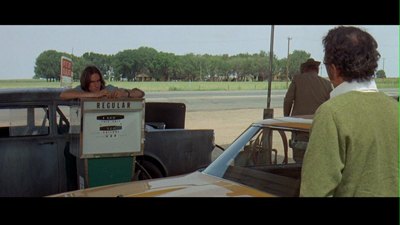
At another juncture, however, GTO tells a traveling Texan (Bill Keller) that he used to be a test pilot that flew jets, and he switched to cars because he needed something to ground him. He also tells the Girl that he needs to find the end of the road before he jumps right off it and goes into orbit; contrary to that, the Chevy duo see no end to the highway. The only real threat is the loss or destruction of their vehicle, something they get close to as an unexpected result of their race with GTO. Out of cash, they have to put their tools up as their stake in a wager, and for the first time, the Mechanic and the Driver get testy with one another. The tools keep the engine running, and without them, the machine could fail.
It's just one of many flip-flops Hellman and Wurlitzer pull in Two-Lane Blacktop. A lot is backwards on their racetrack. It must be significant, for instance, that the old man drives the newer car, trying to make a claim to being part of the present and not a relic of the past. The two younger men, however, drive an older car, placing themselves within a tradition that was over before they even knew what it was. If you consider it that way, it almost seems inevitable that these entities would eventually collide, coming together only to repel one another, two magnetic forces that both attract and repulse.
Where they end up is entirely up to you. They both stick to their original routes, but what they find there is the personal riddle that each viewer brings to the picture. Like the mysterious ending of Easy Rider, this movie's closest cousin, there is no denouement that puts Two-Lane Blacktop into perspective. Unlike Easy Rider, there is no heavy-handed, self-conscious symbolism to sort through, either. The way I see it, the racers continue on, stuck in gear, happy in being doomed to participate in the eternal struggle. Your mileage may vary, though, and that could be Monte Hellman's ultimate statement about the freedom we all seek. Like the open highway, this movie and what it means to you--and life itself--is only limited by the amount of fuel you're willing to expend getting there.
THE DVD
Video:
The Two-Lane Blacktop - Criterion Collection DVD has a brand-new high-def transfer at a 2.35:1 aspect ratio. It's a sparkling picture, free of dirt or scratches, but maintaining the naturally grainy look of the original print.
Sound:
The soundtrack is mixed in 5.1, with lots of nice effects, particularly in relation to the passing cars and the sounds of the road. All of the levels are nice, though, including good separation of music and dialogue. You can also choose a more standard 1-channel option.
English Closed Captioning is also available.
Extras:
The packaging for the Two-Lane Blacktop - Criterion Collection is exceptional. A full-color, sturdy outer slipcase houses both the interior DVD case and a squarebound book reprinting Rudy Wurlitzer's original screenplay. The interior case is made of a thick cardboard/paper that unfolds to reveal a plastic tray for each DVD as well as a pocket for another booklet, this time featuring credits, tributes by musician Tom Waits and film director Richard Linklater (Slacker), a critical essay by Film Comment's Kent Jones, and a reprint of a 1970 Rolling Stone article about the making of Two-Lane Blacktop.
DVD 1 has the main feature along with two audio commentaries. The first features Monte Hellman discussing the movie with director Allison Anders (Border Radio, Mi Vida Loca). The second pairs writer Rudy Wurlitzer with film professor and author David Meyer. Both commentaries are really good, with the two couplings creating involving dialogues. Naturally, the topics covered match the craft of the craftsmen, so Hellman's is more about the actual making of the picture and Wurlitzer's about the larger story concerns. Both talk about what else was going on in the world at the time, and Allison Anders brings her own reflections about being young at the same time as the movie was being made.
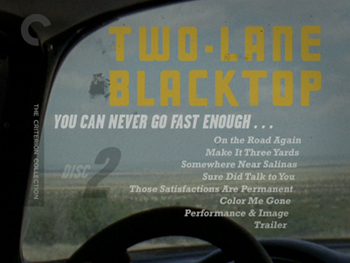
DVD 2 is the supplemental disc. It contains:
* On the Road Again: Two-Lane Blacktop Revisited (43 minutes): A new documentary, shot almost entirely inside a moving vehicle. Monte Hellman and several of his film students, along with his daughter Melissa, who played the girl on the way to the cemetery in Two-Lane, drive to Needles, CA, to see locations from the movie. Along the way, Hellman reminisces about shooting the picture and answers questions. Once they arrive, a really nice editing montage jumps between scenes in the movie and the exact same location today.
* Make it Three Yards: A Conversation with James Taylor (38:30): The star of Two-Lane sits down with its director for the first time since completion. Taylor, who has never seen the film, discusses his impressions of making it and quizzes Hellman about their working relationship, which at times was strained.
* Somewhere Near Salinas: A Conversation with Kris Kristofferson (27:30): Hellman talks to the songwriter about the use of his tune "Me and Bobby McGee" in the movie, as well as his role in Peckinpah's Pat Garett and Billy the Kid, which was also written by Rudy Wurlitzer and can be seen as a kind of kindred endeavor to Two-Lane Blacktop.
* Sure Did Talk to You (23:00): A new documentary compiling multiple interviews with producer Michael Laughlin, production manager Walter Coblenz, and Jared Hellman, who was barely three or four when he appeared in the accident scene in the movie, and as he says, is still the youngest cast member of Two-Lane Blacktop.
* Those Satisfactions are Permanent: Excerpts from the screen tests for Laurie Bird (14:40) and James Taylor (10:45). Bird's goes to multiple locations and also features A.J. Solari, the Tennessee Hitchhiker in the final movie. Taylor mainly converses with Hellman and plays a song he was working on at the time.
* Color Me Gone: An extensive gallery of on-set stills and publicity material.
* Performance and Image: Two sections here. First is an interactive text essay about the history of the cars, along with photographs of them with their various owners, tracing them all the way up to today. Second is a gallery of the locations in the movie.
* Theatrical Trailer.
FINAL THOUGHTS:
Highly Recommended. Two-Lane Blacktop is a grower. On viewing it, I was of no strong opinion about it. Then, as it settled and I reflected on what I had seen, it started to take on new life and impress me more and more. A story of highway nomads racing across the U.S. terrain, it speaks to the changing face of the American frontier experience and how various individuals, young and old, react to their rootlessness. With standout performances by musicians James Taylor and Dennis Wilson next to the veteran actor Warren Oates, this genre picture has a rhythm and feel all its own. The double-disc Two-Lane Blacktop - Criterion Collection is a sharp package, smartly put together with high-octane bonus features that really take you deeper into the movie. A must for fans of road movies, 1970s maverick filmmaking, and cinema verite.
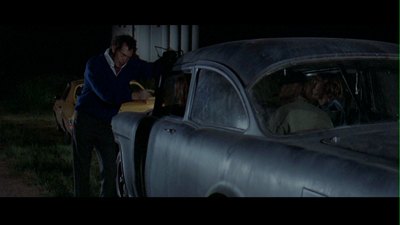
Jamie S. Rich is a novelist and comic book writer. He is best known for his collaborations with Joelle Jones, including the hardboiled crime comic book You Have Killed Me, the challenging romance 12 Reasons Why I Love Her, and the 2007 prose novel Have You Seen the Horizon Lately?, for which Jones did the cover. All three were published by Oni Press. His most recent projects include the futuristic romance A Boy and a Girl with Natalie Nourigat; Archer Coe and the Thousand Natural Shocks, a loopy crime tale drawn by Dan Christensen; and the horror miniseries Madame Frankenstein, a collaboration with Megan Levens. Follow Rich's blog at Confessions123.com.
|
| Popular Reviews |
| Sponsored Links |
|
|
| Sponsored Links |
|
|
| Release List | Reviews | Shop | Newsletter | Forum | DVD Giveaways | Blu-Ray | Advertise |
|
Copyright 2024 DVDTalk.com All Rights Reserved. Legal Info, Privacy Policy, Terms of Use,
Manage Preferences,
Your Privacy Choices | |||||||









